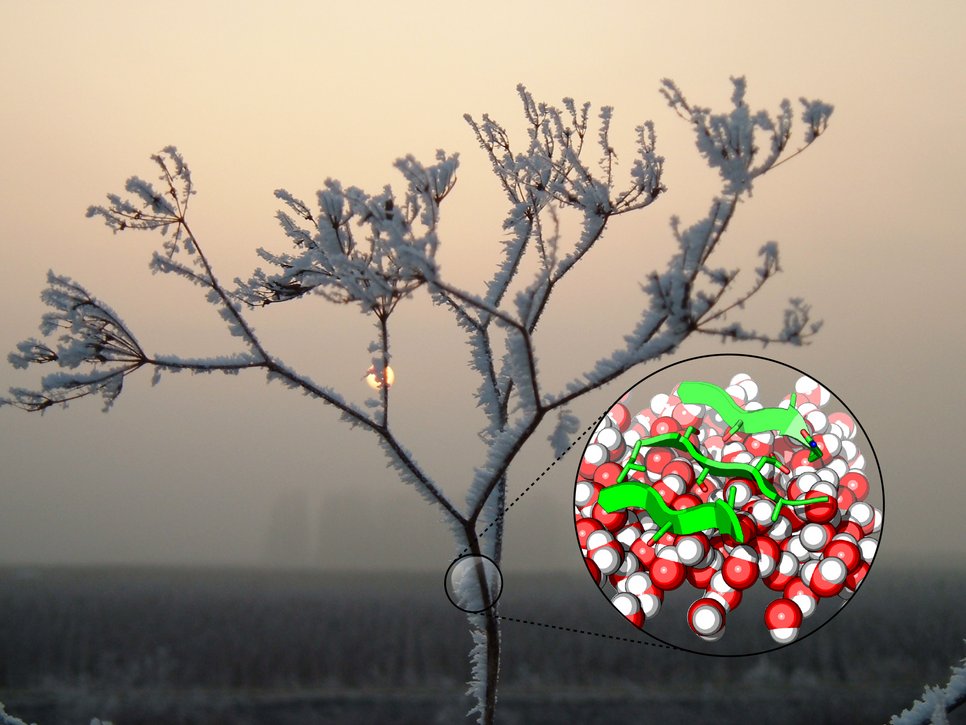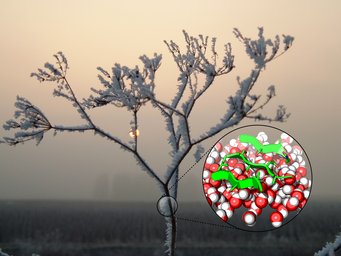How bacteria turn water into ice
Bacteria induce the formation of ice crystals by changing the order and dynamics of surface water molecules.
In absolute pure water droplets, ice crystals will only form at temperatures below -37°C. Only in the presence of crystallization nuclei, water can freeze at 0°C or just below. In the environment, mineral dust particles as well as pollen, fungal spores or bacteria can act as ice nuclei.

It has been known for some time that certain protein molecules anchored to the outer cell membrane of ice-active bacteria (the technical term) can induce the formation of ice crystals. Until recently, however, the molecular mechanisms responsible for this phenomenon have been unclear.
Max Planck researchers have now unraveled the interactions between water and protein molecules at the bacterial surface. A research team headed by Tobias Weidner from the Max Planck Institute for Polymer Research and Janine Fröhlich-Nowoisky from the Max Planck Institute for Chemistry shows how ice-active bacteria influence the order and dynamics of water molecules. Together with American colleagues, the Mainz researchers have reported in the latest edition of the renowned scientific journal “Science Advances” that ice–nucleating proteins generate water domains with increased order and stronger hydrogen bonds. As a result, water molecules can aggregate into ice crystals more easily.
Ice-active bacteria are of great importance to scientists from a variety of different perspectives. They can cause frost damage on the surface of plants and when carried by wind into the atmosphere, they can trigger the formation of precipitation and thus influence the hydrological cycle. The spread of ice-active bacteria and other biological aerosol particles in the atmosphere and their impact on the formation of clouds and precipitation is a much-debated topic in current climate and Earth system research.
To understand how bacterial proteins stimulate the formation of ice crystals, the researchers concentrated on the ice-active bacterium Pseudomonas syringae. This bacterium can trigger the formation of ice crystals beginning at -2 °C, while mineral dust usually triggers the freezing process only below -15 °C. Due to their high ice nucleating ability, devitalized Pseudomonas syringae in the commercial product “Snomax” are used for the production of artificial snow.
Thanks to the new findings it appears possible to imitate the bacterial ice nucleating mechanism and make it usable for other applications. “For the future it is conceivable to produce artificial nano-structured surfaces and particles to selectively influence and control the formation of ice,” predicts Tobias Weidner.
Encouraged by the positive results, the two Max Planck research groups want to extend their cooperation. “We plan to examine the ice-nucleating proteins in isolated form and also to extend the analyses to fungal ice nuclei. Currently, we are still analyzing whole bacterial cells and cell fragments,” explains Janine Fröhlich-Nowoisky, whose working group specializes in the characterization of biological ice nuclei and has both ice-active bacteria and an extensive collection of cultures from ice-active fungi available.
